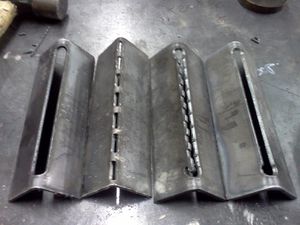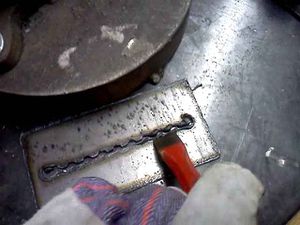TorchTableTraining: Difference between revisions
| Line 19: | Line 19: | ||
== Fold patterns == | == Fold patterns == | ||
[[File:fold_tests.svg|thumb]] [[File:fold_samples.jpg|thumb]] | [[File:fold_tests.svg|thumb]] [[File:fold_samples.jpg|thumb]] [[File:slag_chipping.jpg|thumb]] | ||
My first parts. Using 11ga (0.120" thick) mild steel sheet, cut four 3x6 inch coupons with fold features. Three patterns with relatively wide slots were prepared in inkscape and a fourth simple "dotted line" pattern was prepared at the machine (no file kept). | My first parts. Using 11ga (0.120" thick) mild steel sheet, cut four 3x6 inch coupons with fold features. Three patterns with relatively wide slots were prepared in inkscape and a fourth simple "dotted line" pattern was prepared at the machine (no file kept). | ||
The dotted-line fold worked quite well. This sample was about 70% perforated with 1/4-inch webs remaining. | The dotted-line fold worked quite well. This sample was about 70% perforated with 1/4-inch webs remaining. | ||
The plasma cut left quite a bit of dross/slag. It was easy (if time-consuming) to remove it with a hammer (at the outside edges) or a chisel. | |||
[[Category:Training]] | [[Category:Training]] | ||
[[Category:Torch Table]] | [[Category:Torch Table]] | ||
Revision as of 07:09, 12 December 2012
Chuck Harrison Torch Table Training
I signed up for a class offered local to me (Seattle) by Rusty Oliver. First session 27-Nov-2012.
Rusty has a 5x10 ft Torchmate table with a Hypertherm PowerMax 1000 plasma cutter good for about 60 amps. It cuts 3/8-in comfortably and struggles with 1/2-in steel.
Notes:
- Plasma cutting takes a lot of compressed air, count on a 3-5 hp compressor with a 60 gal tank.
- Moist air cuts down lifetime of the consumables (torch electrode parts) dramatically. Use filter-driers.
- Torch height is critical to good cut quality. 1/8-1/4 inch is typical.
- Rusty has a Torchmate automatic height control Z axis but it has not been very effective. Tends to hunt up and down
- Z axis is a servo (not stepper), which means it can sense stall via motor current
- To find part surface prior to striking arc, Z axis drives torch down until it hits part, then backs up
- During cutting, Z axis is controlled to maintain a desired arc voltage
- Different standoff heights are used for piercing and subsequent cutting.
- Automatic height control is a separate module (not part of the PC-based software) with several programmable parameters
- Torchmate software provides basic 2D drawing capability, tool path generation (kerf allowance), import DXF, svg. Generates and executes G code. Many features I have not learned about yet. Tutorial from Yale, MIT.
- Cut quality is worse than I expected. Lots of dross and several degrees bevel in ~3/16-inch thick steel. From manufacturer videos I think it can be done better.
- There are problems with torch cutting bolt holes. Piercing is hard on the torch (wears out consumables). The hole is tapered, may not be perfectly round, and can't be easily drilled out because of the hardened heat-affected-zone left by the torch. Not impossible, just not easy.
Fold patterns
My first parts. Using 11ga (0.120" thick) mild steel sheet, cut four 3x6 inch coupons with fold features. Three patterns with relatively wide slots were prepared in inkscape and a fourth simple "dotted line" pattern was prepared at the machine (no file kept).
The dotted-line fold worked quite well. This sample was about 70% perforated with 1/4-inch webs remaining.
The plasma cut left quite a bit of dross/slag. It was easy (if time-consuming) to remove it with a hammer (at the outside edges) or a chisel.


